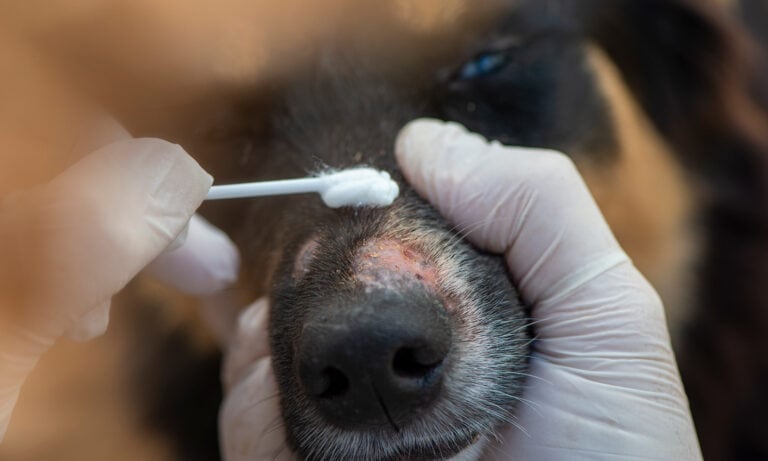Is your best friend walking funny or holding up a paw? If so, you’re probably wondering, “why is my dog limping?” Lameness in dogs is not necessarily a medical emergency, but it could be. Anything from a thorn to a torn ligament to a bone tumor can cause dog limping, and the treatment for each is very different.
Possible Reasons a Dog Is Limping
Anything that causes pain or affects a dog’s ability to walk can cause dog limping such as:
- Infections
- Inflammation
- Cancer
- Chronic degenerative joint disorders
- Developmental problems
- Broken bones
- Torn ligaments
- Ligament disease
- Joint dysplasia
Sudden vs. Long-Term Limping in Dogs
Whether your pet’s limping seemed to come out of the blue or happened slowly over time is important information to know.
Sudden limping is usually a result of trauma or injury. Causes of sudden dog limping include:
- Torn ligament in the knee
- Dislocated hip or elbow
- Sprained or strained muscle, ligament or tendon
- Nerve injury, or a pinched nerve
- Bone fractures
- Lacerated or burned paw pad
- Thorn in the foot
- Bone infection
- Bone cancer (which can also cause long-term limping)
- Panosteitis (“growing pains” seen in young dogs)
- Insect bite or sting
- Vaccine reaction
- Tick bite infections (Lyme or Ehrlichiosis)
Some dogs have chronic conditions, like osteoarthritis or undiagnosed bone tumors, that become irritated with exercise, and might be the source of sudden limping. Unless you can resolve the problem yourself (such as pull out a thorn), then sudden limping is considered painful and could even be an emergency. Your veterinarian is your best resource for determining the root cause and resolving the issue.
Gradual onset limps are exactly what they sound like: limping that slowly gets worse over time. Causes of gradual dog limping include:
- Osteoarthritis
- Hip dysplasia
- Elbow dysplasia
- Chronic back problems
If you notice gradual onset limps in your pooch, a trip to the vet is definitely warranted.
Determining Why Your Dog Is Limping
The vet will need to know your furry friend’s age, breed, spay/neuter status, any other diseases your pet may have, whether or not your dog is on any meds or heartworm prevention, and their vaccination history.
You could be asked the following:
- Which leg (or legs) are affected?
- Is your dog limping on the back leg or legs?
- Is your dog limping on the front leg or legs?
- Is your dog limping on both the back and front legs?
- How long has the limping been going on?
- Can you think of something that caused it?
- Any history of joint disease known in the parents of your dog?
- Is it worse after exercise?
A full physical exam will likely occur, including everything from taking vitals (temperature, respiratory rate and heart rate) to an orthopedic assessment. The vet may also want to watch your dog’s gait and closely observe your pet’s movement: to see if your dog is limping on their front leg, or if your dog’s limping on the back leg, for example.
Other assessments might encompass:
- X-rays. (Your dog may need to be sedated to get good pictures of bones, muscles, joints and ligaments.)
- Blood samples.
- Magnetic resonance imaging (MRI).
- Joint taps (drawing fluid from the joints)
Treatment of Dog Limping
Of course, your main concern is helping your buddy feel better, so a big part of the treatment for dog limping will consist of pain management. Learn more about what you can give a dog for pain.
Addressing the root cause is also crucial.
- If your dog is limping due to osteoarthritis, treatment might comprise a hodgepodge of things like:
- pain management
- weight management
- a joint supplement
- physical therapy
- exercise
- If your dog is limping due to an injury or bone tumor, surgery might be needed.
- If your dog is limping due to an infection, then antibiotics and pain relievers with anti-inflammatory properties are typically prescribed.
At-Home Care for Dog Limping
For Dogs Recovering From Surgery or Other Procedures: Your dog will probably be under some exercise restrictions to allow for healing, and may need to do physical therapy. Follow all instructions, and give all medications as directed because how well your beloved critter recovers from any procedure will affect the long-term outcome.
For Dogs Limping Due to Osteoarthritis:
- Make sure your dog is comfortable.
- Look into pain management options, including:
-
- Medication
- Supplements
- Photobiomodulation (Laser therapy)
- Acupuncture
- Canine rehabilitation (water therapy, electrotherapy, etc.)
- Passive range of motion exercises
- Massage
- Talk with your veterinarian to determine the best choices for your dog.
- Set up a supportive sleeping surface, such as Big Barker's Orthopedic Dog Crate Pad.
- Provide pet ramps for your pup to get up and down, if needed.
Dog Limping FAQs
Q:
Why is my dog limping without a sign of pain?
A:
It would be highly unusual for a dog to limp without being in pain, but it can be hard for pet parents to gauge pain status. It’s natural to think a hurting dog will make noise (whine or yelp), but that’s not necessarily so. Dogs experiencing chronic pain, sometimes won’t make any sounds at all to show discomfort. Bottom line: If a dog is limping, then that dog is in pain. Some things to look out for: •
- Activity Level. Ask yourself: What’s the dog’s overall energy level? Has their activity decreased, or do they just seem more tired than usual?
- Medication Response. If giving a pain reliever increases a dog’s activity, that indicates they’ve been in pain. Just remember never to give pain relievers, or any other medications, without first getting your veterinarian’s OK.
Q:
Why is my dog limping after sleeping?
A:
This may occur for several reasons:
- Arthritis. If a dog is starting to get arthritis, they might be stiff and sore and walk with a limp after lying down for a while.
- Their leg may be asleep. If a dog’s leg goes to sleep, just like humans, they might walk funny or decide to not move at all until they regain sensation. If the affected leg feels weird, you might see them licking or biting at their sleepy limb.
- Injury or Disease. They may not have been limping before going to sleep, but if your dog has an unseen injury or a hidden illness, being in one position for an extended amount of time might aggravate the area and cause limping.
Q:
My dog was limping, but now it stopped. Should I be concerned?
A:
You should definitely be concerned if the dog limping comes back again, if you see a visible injury or swelling, or if you’re just plain worried. These signs might mean:
- Your pet has a strain, a pulled muscle or may have stepped on something.
- The dog has arthritis, which can cause them to feel stiffness at certain times (like post sleep or exercise) but then seemingly bounce right back to their normal, happy pup selves.
- A young dog exhibiting panosteitis symptoms. Known as “growing pains,” this inflammatory condition of the long bones might shift to different legs.
Read More
Share:










